Glider-Based Active Acoustic Monitoring of Currents and Turbidity in the Coastal Zone
Abstract
:1. Introduction
2. Materials and Methods
2.1. Deployment Strategy
2.2. Environmental Data
2.3. Glider Data
2.3.1. Glider System, CTD, and Optical Sensors
2.3.2. Optical Data Processing
2.3.3. ADCP Settings
2.4. ADCP Data Processing
2.4.1. Estimation of Backscatter Index
2.4.2. Water Velocity Estimates
3. Results
3.1. Observations Context
3.2. Hydrological Conditions
3.3. Hydrodynamical Conditions
3.3.1. Validation of Current Measurements
3.3.2. Characteristics of Observed Coastal Currents
3.4. Cross-Shelf Variability of Biogeochemical Variables
4. Discussion
4.1. Currents Observation by Glider-Mounted ADCP
4.2. Turbidity Observation by Glider Optical and ADCP Sensors
4.3. Estimates of SPM Fluxes
4.4. SPM Dynamics from Glider vs. Satellite Observations
5. Conclusions
- In line with previous studies, our comparison of currents estimated from ADCP data with the DAC confirms that this system is suitable for measuring currents in coastal areas, with an uncertainty of 0.13 m s−1. The repeated glider transects across the shelf show the importance of freshwater input from the Rhone River as one of the main drivers of local hydrodynamics.
- In order to qualify the results by comparison with the DAC, we employed the shear method to determine absolute currents. We applied the bottom track constraint to near-bottom currents. Unfortunately, this constraint was seen to have a fairly high uncertainty due to the low ADCP sampling frequency.
- Coincident optical and acoustic backscatter measurements show complementarity in the characterization of small and large suspended particles, respectively. Analysis of optical spikes and acoustic backscatter indicates the presence of coarse particles on the proximal part of the mid-shelf close to the river mouth, where hydrological conditions likely favor the formation of macro flocs.
- The calculated SPM fluxes and their uncertainties (20–600%) are highly variable. Furthermore, the SPM fluxes on the shelf are one order of magnitude lower than the concomitant SPM fluxes from the nearby Rhone River, which suggests a significant deposition of particulate matter at the river mouth.
- The combination of both satellite and glider SPM measurements is important for monitoring both surface and subsurface parts of the river plume.
- The sampling strategy used in this study showed that the monitoring of currents and turbidity in the coastal zone over periods ranging from several weeks to several months is feasible. This technique enables the capture of difficult to monitor sporadic events such as storms or floods, which is essential both for improving existing knowledge of coastal circulation and sediment transport, and for the validation of hydro-sedimentary regional models.
Author Contributions
Funding
Acknowledgments
Conflicts of Interest
References
- Durrieu De Madron, X.; Wiberg, P.L.; Puig, P. Sediment dynamics in the Gulf of Lions: The impact of extreme events. Cont. Shelf Res. 2008, 28, 1867–1876. [Google Scholar] [CrossRef]
- Ody, A.; Doxaran, D.; Vanhellemont, Q.; Nechad, B.; Novoa, S.; Many, G.; Bourrin, F.; Verney, R.; Pairaud, I.; Gentili, B. Potential of High Spatial and Temporal Ocean Color Satellite Data to Study the Dynamics of Suspended Particles in a Micro-Tidal River Plume. Remote Sens. 2016, 8, 245. [Google Scholar] [CrossRef] [Green Version]
- Gohin, F. Annual cycles of chlorophyll-a, non-algal suspended particulate matter, and turbidity observed from space and in-situ in coastal waters. Ocean Sci. 2011, 7, 705–732. [Google Scholar] [CrossRef] [Green Version]
- Doxaran, D.; Froidefond, J.-M.; Castaing, P.; Babin, M. Dynamics of the turbidity maximum zone in a macrotidal estuary (the Gironde, France): Observations from field and MODIS satellite data. Estuar. Coast. Shelf Sci. 2009, 81, 321–332. [Google Scholar] [CrossRef]
- Bourrin, F.; Many, G.; Durrieu De Madron, X.; Martin, J.; Puig, P.; Houpert, L.; Testor, P.; Kunesch, S.; Mahiouz, K.; Beguery, L. Glider monitoring of shelf suspended particle dynamics and transport during storm and flooding conditions. Cont. Shelf Res. 2015, 109, 135–149. [Google Scholar] [CrossRef]
- Miles, T.; Seroka, G.; Kohut, J.T.; Schofield, O.M.; Glenn, S. Glider observations and modeling of sediment transport in Hurricane Sandy. J. Geophys. Res. Oceans 2015, 120, 1771–1791. [Google Scholar] [CrossRef] [Green Version]
- Miles, T.; Glenn, S.; Kohut, J.; Seroka, G.; Xu, Y. Observations of Hurricane Sandy from a glider mounted aquadopp profiler. In Proceedings of the Oceans 2013 Mtsieee—San Diego Ocean Common, San Diego, CA, USA, 23–27 September 2013. [Google Scholar]
- Glenn, S.; Jones, C.; Twardowski, M.; Bowers, L.; Kerfoot, J.; Kohut, J.T.; Webb, D.; Schofield, O.M. Glider observations of sediment resuspension in a Middle Atlantic Bight fall transition storm. Limnol. Oceanogr. 2008, 53, 2180–2196. [Google Scholar] [CrossRef] [Green Version]
- Davis, R.; Eriksen, C.; Jones, C. Autonomous Buoyancy-Driven Underwater Gliders. In Technology and Applications of Autonomous Underwater Vehicles; Routledge: London, UK, 2002; pp. 37–58. [Google Scholar] [CrossRef]
- Liblik, T.; Karstensen, J.; Testor, P.; Alenius, P.; Hayes, D.; Ruiz, S.; Heywood, K.J.; Pouliquen, S.; Mortier, L.; Mauri, E. Potential for an underwater glider component as part of the Global Ocean Observing System. Methods Oceanogr. 2016, 17, 50–82. [Google Scholar] [CrossRef] [Green Version]
- Rudnick, D.L. Ocean Research Enabled by Underwater Gliders. Annu. Rev. Mar. Sci. 2015, 8, 519–541. [Google Scholar] [CrossRef]
- Testor, P. Gliders as a Component of Future Observing Systems. In Proceedings of the OceanObs’09: Sustained Ocean Observations and Information for Society, Venice, Italy, 21–25 September 2009; p. 978. [Google Scholar]
- Ma, W.; Wang, Y.; Wang, S.; Zhang, H.; Zhang, H.; Gong, Q. Absolute Current Estimation and Sea-Trial Application of Glider-Mounted AD2CP. J. Coast. Res. 2019, 35, 1343–1350. [Google Scholar] [CrossRef]
- Todd, R.E. High-Frequency internal waves and thick bottom mixed layers observed by gliders in the Gulf Stream. Geophys. Res. Lett. 2017, 44, 6316–6325. [Google Scholar] [CrossRef]
- Todd, R.E.; Rudnick, D.L.; Mazloff, M.R.; Davis, R.E.; Cornuelle, B. Poleward flows in the southern California Current System: Glider observations and numerical simulation. J. Geophys. Res. Oceans 2011, 116, 116. [Google Scholar] [CrossRef] [Green Version]
- Ellis, D.; Washburn, L.; Ohlmann, C.; Gotschalk, C. Improved methods to calculate depth-resolved velocities from glider-mounted ADCPs. In Proceedings of the 2015 IEEE/OES Eleveth Current, Waves and Turbulence Measurement (CWTM), St. Petersburg, FL, USA, 2–6 March 2015; pp. 1–10. [Google Scholar] [CrossRef]
- Ouillon, S. Why and How Do We Study Sediment Transport? Focus on Coastal Zones and Ongoing Methods. Water 2018, 10, 390. [Google Scholar] [CrossRef]
- Sadaoui, M.; Ludwig, W.; Bourrin, F.; Raimbault, P. Controls, budgets and variability of riverine sediment fluxes to the Gulf of Lions (NW Mediterranean Sea). J. Hydrol. 2016, 540, 1002–1015. [Google Scholar] [CrossRef]
- Garau, B.; Ruiz, S.; Zhang, W.G.; Pascual, A.; Heslop, E.; Kerfoot, J.; Tintoré, J. Thermal Lag Correction on Slocum CTD Glider Data. J. Atmos. Ocean. Technol. 2011, 28, 1065–1071. [Google Scholar] [CrossRef] [Green Version]
- Mcdougall, T.; Feistel, R.; Millero, F.; Jackett, D.R.; Wright, D.; King, B.; Marion, G.; Chen, C.-T.A.; Spitzer, P. The International Thermodynamic Equation of Seawater 2010 (TEOS-10): Calculation and Use of Thermodynamic Properties; IOC UNESCO: Paris, France, 2010.
- Sullivan, J.M.; Twardowski, M.S.; Ronald, J.; Zaneveld, V.; Moore, C.C.; Kokhanovsky, A.A. Measuring optical backscattering in water. Light Scatt. Rev. 2013, 7, 189–224. [Google Scholar] [CrossRef]
- Styles, R. Laboratory evaluation of the LISST in a stratified fluid. Mar. Geol. 2006, 227, 151–162. [Google Scholar] [CrossRef]
- Quan, X.; Fry, E.S. Empirical equation for the index of refraction of seawater. Appl. Opt. 1995, 34, 3477–3480. [Google Scholar] [CrossRef]
- Briggs, N.; Perry, M.J.; Cetinić, I.; Lee, C.; D’Asaro, E.; Gray, A.M.; Rehm, E. High-Resolution observations of aggregate flux during a sub-polar North Atlantic spring bloom. Deep. Sea Res. Part. I Oceanogr. Res. Pap. 2011, 58, 1031–1039. [Google Scholar] [CrossRef]
- Mullison, J.; DeCollibus, C.; Allsup, B. An investigation of the accuracy of current profile measurements from a glider-mounted ADCP operating in shallow water. In Proceedings of the 2013 OCEANS—San Dego, San Diego, CA, USA, 23–27 September 2013; pp. 1–8. [Google Scholar]
- Ordonez, C.E.; Shearman, R.K.; Barth, J.A.; Welch, P.; Erofeev, A.; Kurokawa, Z. Obtaining absolute water velocity profiles from glider-mounted Acoustic Doppler Current Profilers. In Proceedings of the 2012 Oceans—Yeosu, Yeosu, Korea, 21–24 May 2012; p. 7, ISBN 978-1-4577-2089-5. [Google Scholar]
- Gordon, R.L. Acoustic Doppler current profiler-Principles of operation: A practical primer. RD Instrum. 1996, 54, 54. [Google Scholar]
- Deines, K.L. Backscatter estimation using Broadband acoustic Doppler current profilers. In Proceedings of the IEEE Sixth Working Conference on Current Measurement (Cat. No.99CH36331), San Diego, CA, USA, 13 March 1999; pp. 249–253. [Google Scholar]
- Gostiaux, L.; Van Haren, H. Extracting Meaningful Information from Uncalibrated Backscattered Echo Intensity Data. J. Atmos. Ocean. Technol. 2010, 27, 943–949. [Google Scholar] [CrossRef]
- Mullison, J. Backscatter Estimation Using Broadband Acoustic Doppler Current Profilers-Updated. In Proceedings of the ASCE Hydraulic Measurements & Experimental Methods Conference, Durham, NH, USA, 9–12 July 2017. [Google Scholar]
- Francois, R.E.; Garrison, G.R. Sound absorption based on ocean measurements. Part II: Boric acid contribution and equation for total absorption. J. Acoust. Soc. Am. 1982, 72, 1879–1890. [Google Scholar] [CrossRef]
- Merckelbach, L.; Smeed, D.A.; Griffiths, G. Vertical Water Velocities from Underwater Gliders. J. Atmos. Ocean. Technol. 2010, 27, 547–563. [Google Scholar] [CrossRef] [Green Version]
- Frajka-Williams, E.; Eriksen, C.C.; Rhines, P.B.; Harcourt, R.R. Determining Vertical Water Velocities from Seaglider. J. Atmos. Ocean. Technol. 2011, 28, 1641–1656. [Google Scholar] [CrossRef]
- Visbeck, M. Deep Velocity Profiling Using Lowered Acoustic Doppler Current Profilers: Bottom Track and Inverse Solutions. J. Atmos. Ocean. Technol. 2002, 19, 794–807. [Google Scholar] [CrossRef]
- Firing, E.; Gordon, R.L. Deep ocean acoustic Doppler current profiling. In Proceedings of the IEEE Fourth Working Conference on Current Measurement, IEEE, Clinton, MD, USA, 3–5 April 1990; pp. 192–201. [Google Scholar]
- Fischer, J.; Visbeck, M. Deep Velocity Profiling with Self-contained ADCPs. J. Atmos. Ocean. Technol. 1993, 10, 764–773. [Google Scholar] [CrossRef]
- Thurnherr, A.M.; Symonds, D.; Laurent, L.S. Processing explorer ADCP data collected on slocum gliders using the LADCP shear method. In Proceedings of the 2015 IEEEOES 11th Current Waves and Turbulence Measurment CWTM, St. Petersburg, FL, USA, 2–6 March 2015. [Google Scholar] [CrossRef]
- Millot, C. Wind induced upwellings in the Gulf of Lions. Oceanol. Acta 1979, 2, 261–274. [Google Scholar]
- Estournel, C.; Durrieu de Madron, X.; Marsaleix, P.; Auclair, F.; Julliand, C.; Vehil, R. Observation and modeling of the winter coastal oceanic circulation in the Gulf of Lion under wind conditions influenced by the continental orography (FETCH experiment). J. Geophys. Res. Oceans 2003, 108, 108. [Google Scholar] [CrossRef]
- Reffray, G.; Marsaleix, P.; Fraunié, P. Secondary flows induced by wind forcing in the Rhône region of freshwater influence. Ocean Dyn. 2004, 54, 179–196. [Google Scholar] [CrossRef]
- Petrenko, A.; Dufau, C.; Estournel, C. Barotropic eastward currents in the western Gulf of Lion, north-western Mediterranean Sea, during stratified conditions. J. Mar. Syst. 2008, 74, 406–428. [Google Scholar] [CrossRef]
- Schaeffer, A.; Garreau, P.; Molcard, A.; Fraunié, P.; Seity, Y. Influence of high-resolution wind forcing on hydrodynamic modeling of the Gulf of Lions. Ocean Dyn. 2011, 61, 1823–1844. [Google Scholar] [CrossRef]
- Millot, C. The Gulf of Lions’ hydrodynamics. Cont. Shelf Res. 1990, 10, 885–894. [Google Scholar] [CrossRef]
- Petrenko, A.A. Variability of circulation features in the Gulf of Lion NW Mediterranean Sea. Importance of inertial currents. Oceanol. Acta 2003, 26, 323–338. [Google Scholar] [CrossRef] [Green Version]
- Chereskin, T.K.; Levine, M.D.; Harding, A.J.; Regier, L.A. Observations of near-inertial waves in acoustic Doppler current profiler measurements made during the Mixed Layer Dynamics Experiment. J. Geophys. Res. Oceans 1989, 94, 8135. [Google Scholar] [CrossRef]
- Lynch, J.F.; Irish, J.D.; Sherwood, C.R.; Agrawal, Y.C. Determining suspended sediment particle size information from acoustical and optical backscatter measurements. Cont. Shelf Res. 1994, 14, 1139–1165. [Google Scholar] [CrossRef]
- Downing, J. Twenty-Five years with OBS sensors: The good, the bad, and the ugly. Cont. Shelf Res. 2006, 26, 2299–2318. [Google Scholar] [CrossRef]
- Many, G.; Bourrin, F.; Durrieu De Madron, X.; Pairaud, I.; Gangloff, A.; Doxaran, D.; Ody, A.; Verney, R.; Menniti, C.; Le Berre, D.; et al. Particle assemblage characterization in the Rhone River ROFI. J. Mar. Syst. 2016, 157, 39–51. [Google Scholar] [CrossRef] [Green Version]
- Lohrmann, A. Monitoring sediment concentration with acoustic backscattering instruments. Nortek Tech. Note 2001, 3, 1–5. [Google Scholar]
- Miles, T.; Kohut, J.T.; Slade, W.; Gong, D. Suspended particle characteristics from a glider integrated LISST sensor. In Proceedings of the OCEANS 2018 MTS/IEEE Charleston, Charleston, SC, USA, 22–25 October 2018; pp. 1–5. [Google Scholar] [CrossRef]
- Guillén, J.; Bourrin, F.; Palanques, A.; De Madron, X.D.; Puig, P.; Buscail, R. Sediment dynamics during wet and dry storm events on the Têt inner shelf (SW Gulf of Lions). Mar. Geol. 2006, 234, 129–142. [Google Scholar] [CrossRef]
- Palanques, A.; Guillén, J.; Puig, P.; Durrieu De Madron, X. Storm-Driven shelf-to-canyon suspended sediment transport at the southwestern Gulf of Lions. Cont. Shelf Res. 2008, 28, 1947–1956. [Google Scholar] [CrossRef]
- Bourrin, F.; Friend, P.; Amos, C.; Manca, E.; Ulses, C.; Palanques, A.; De Madron, X.D.; Thompson, C. Sediment dispersal from a typical Mediterranean flood: The Têt River, Gulf of Lions. Cont. Shelf Res. 2008, 28, 1895–1910. [Google Scholar] [CrossRef]
- Bourrin, F.; De Madron, X.D.; Heussner, S.; Estournel, C. Impact of winter dense water formation on shelf sediment erosion (evidence from the Gulf of Lions, NW Mediterranean). Cont. Shelf Res. 2008, 28, 1984–1999. [Google Scholar] [CrossRef]
- Dufois, F.; Verney, R.; Le Hir, P.; Dumas, F.; Charmasson, S. Impact of winter storms on sediment erosion in the Rhone River prodelta and fate of sediment in the Gulf of Lions (North Western Mediterranean Sea). Cont. Shelf Res. 2013, 72, 57–72. [Google Scholar] [CrossRef] [Green Version]
- Gangloff, A. Devenir des Apports Solides du Rhône dans le Golfe du Lion: Étude de la Dynamique du Panache Turbide du Rhône en Réponse aux Forçages Hydrométéorologiques. Ph.D. Thesis, Université de Bretagne Occidentale, Brest, France, 2017. [Google Scholar]
- Noël, M.-H. Le Plutonium Comme Traceur du Transfert et de l’accumulation des Apports Particulaires du Rhône en Méditerranée Nord Occidentale. Ph.D. Thesis, Université Paris-Est Créteil Val de Marne (UPEC), Créteil, France, 1996. [Google Scholar]
- Lansard, B. Distribution et Remobilisation du Plutonium dans les Sédiments du Prodelta du Rhône. Ph.D. Thesis, Université de la Méditerranée—Aix-Marseille II, Marseille, France, 2004. [Google Scholar]
- Maillet, G.M.; Vella, C.; Berné, S.; Friend, P.L.; Amos, C.L.; Fleury, T.J.; Normand, A. Morphological changes and sedimentary processes induced by the December 2003 flood event at the present mouth of the Grand Rhône River (southern France). Mar. Geol. 2006, 234, 159–177. [Google Scholar] [CrossRef] [Green Version]
- Castelao, R.M.; Glenn, S.; Schofield, O.M.; Chant, R.; Wilkin, J.; Kohut, J. Seasonal evolution of hydrographic fields in the central Middle Atlantic Bight from glider observations. Geophys. Res. Lett. 2008, 35, 35. [Google Scholar] [CrossRef]
- Many, G.; Bourrin, F.; De Madron, X.D.; Ody, A.; Doxaran, D.; Cauchy, P. Glider and satellite monitoring of the variability of the suspended particle distribution and size in the Rhône ROFI. Prog. Oceanogr. 2018, 163, 123–135. [Google Scholar] [CrossRef] [Green Version]
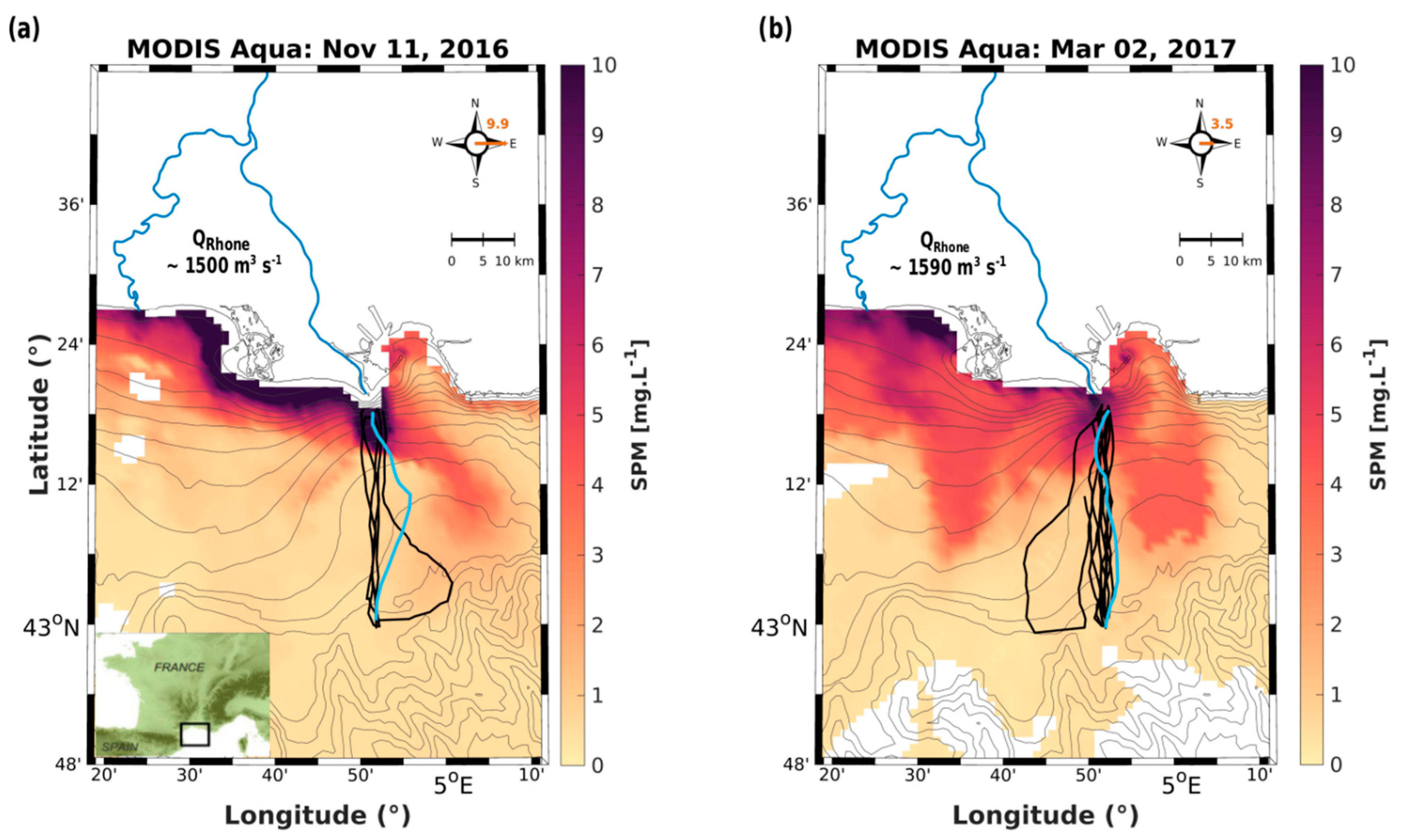

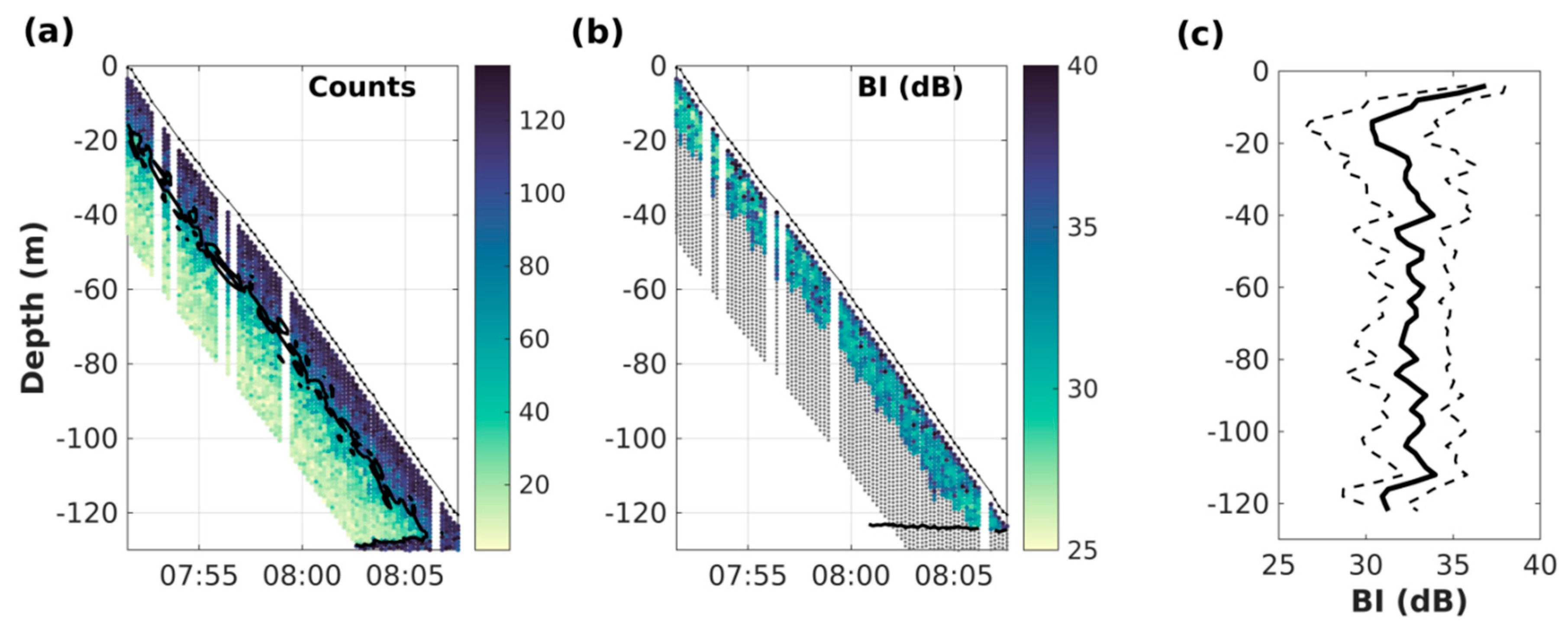
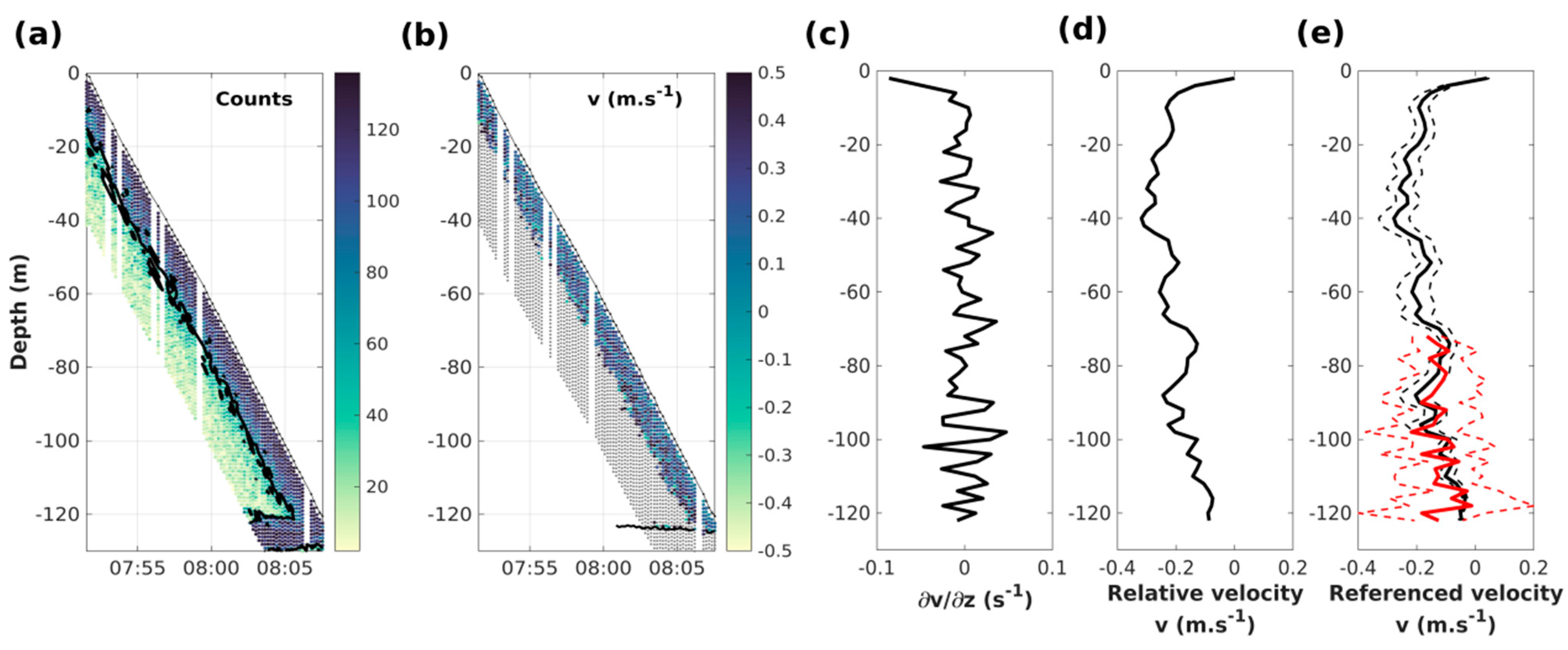

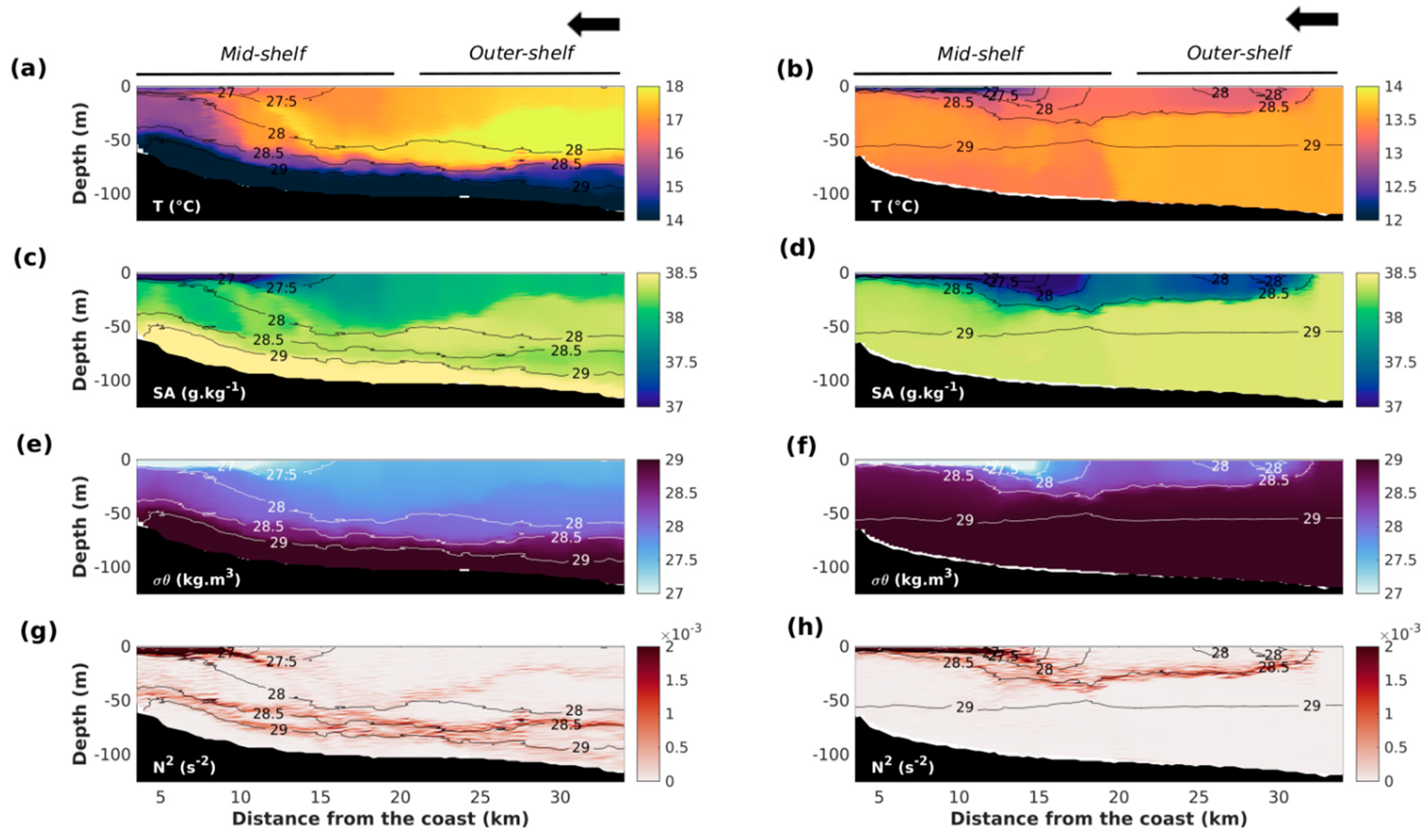
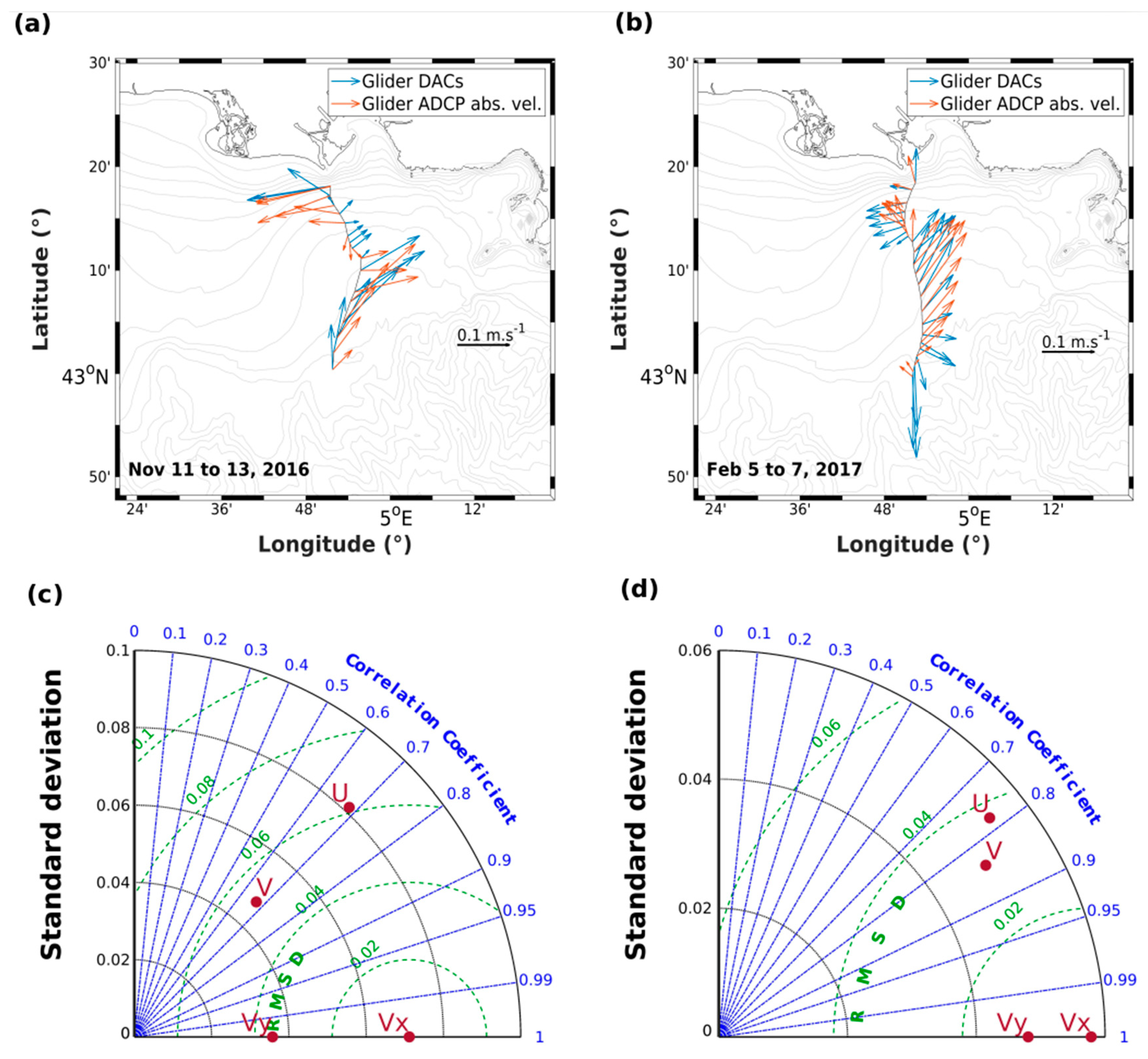

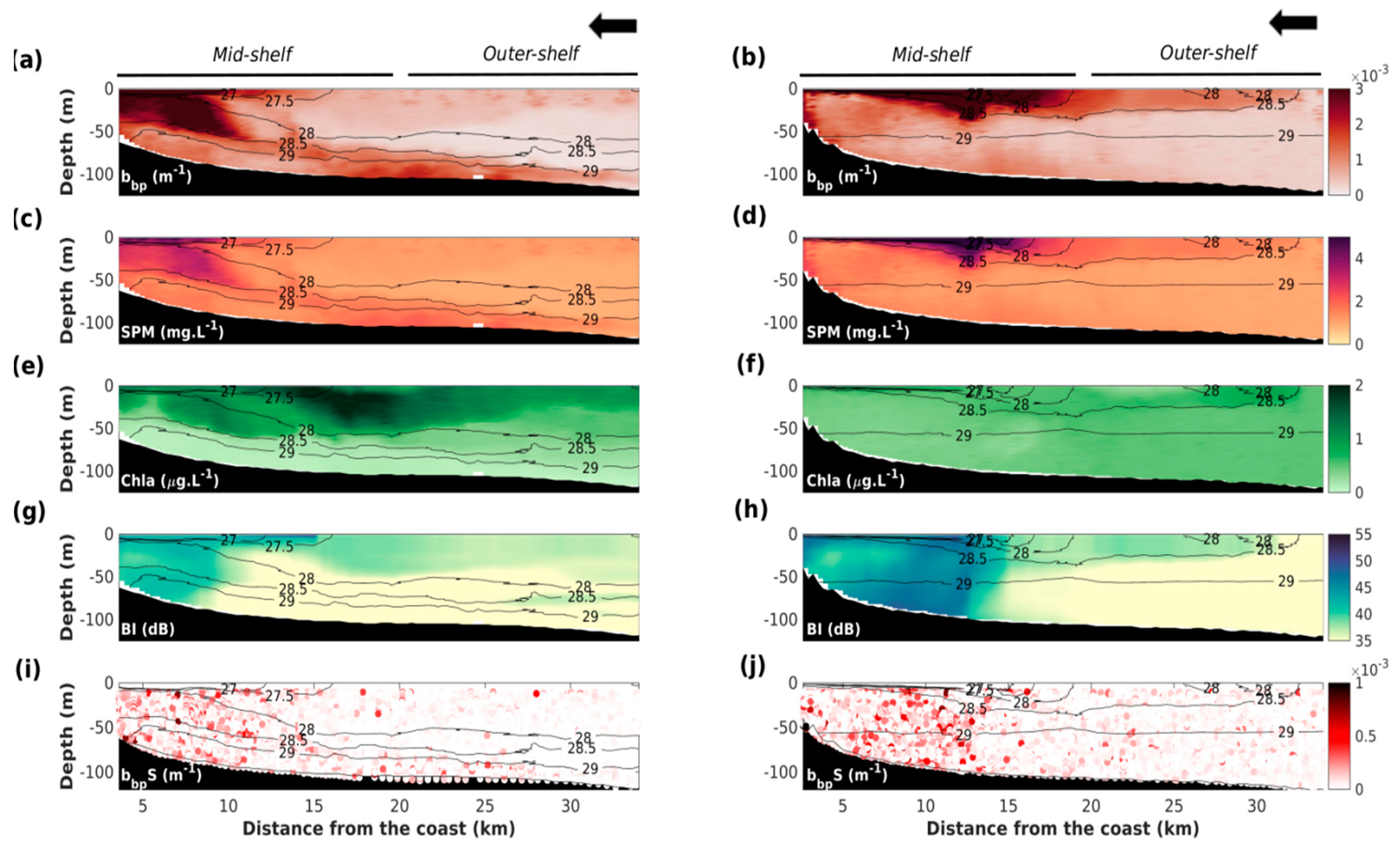
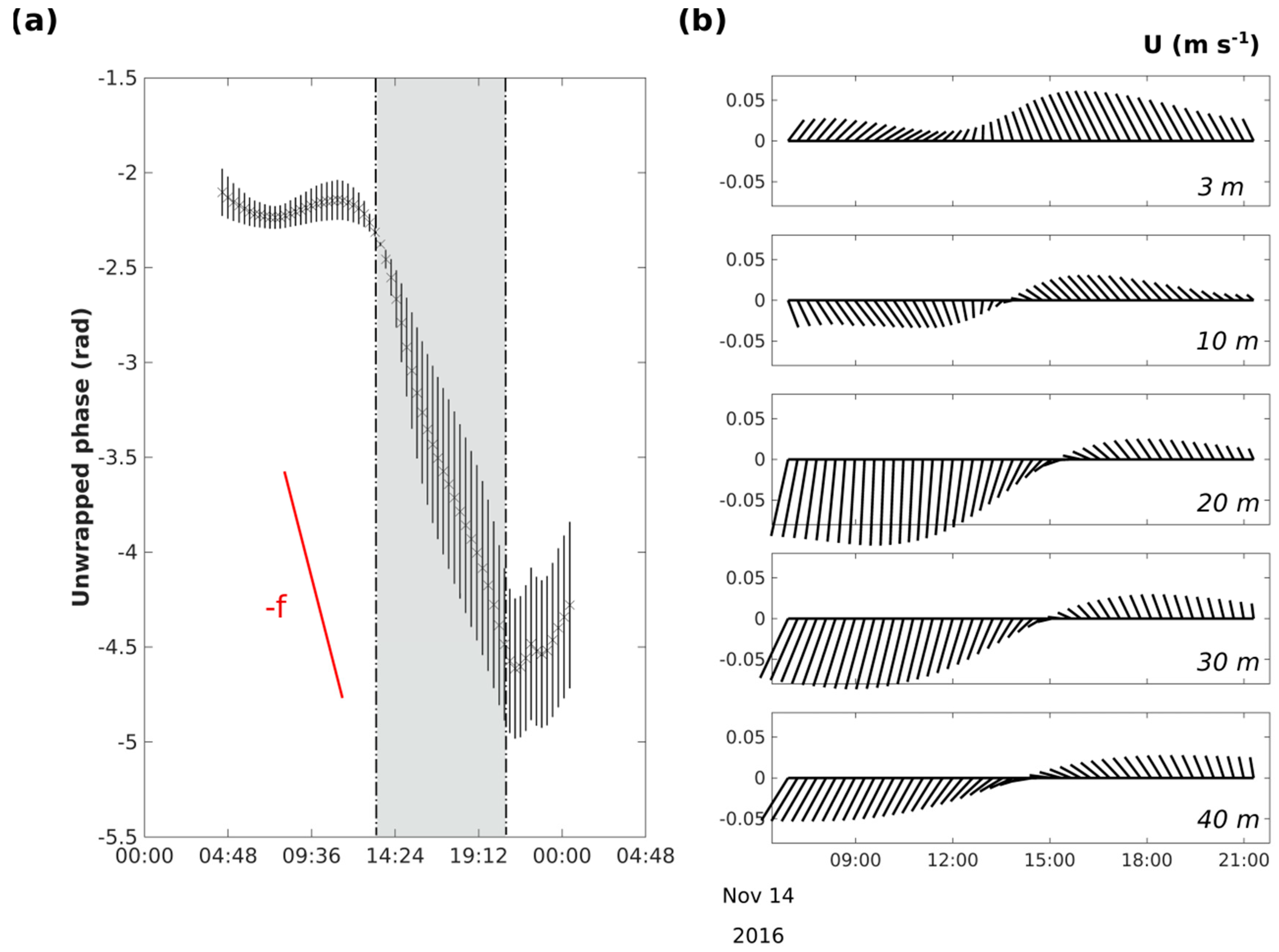
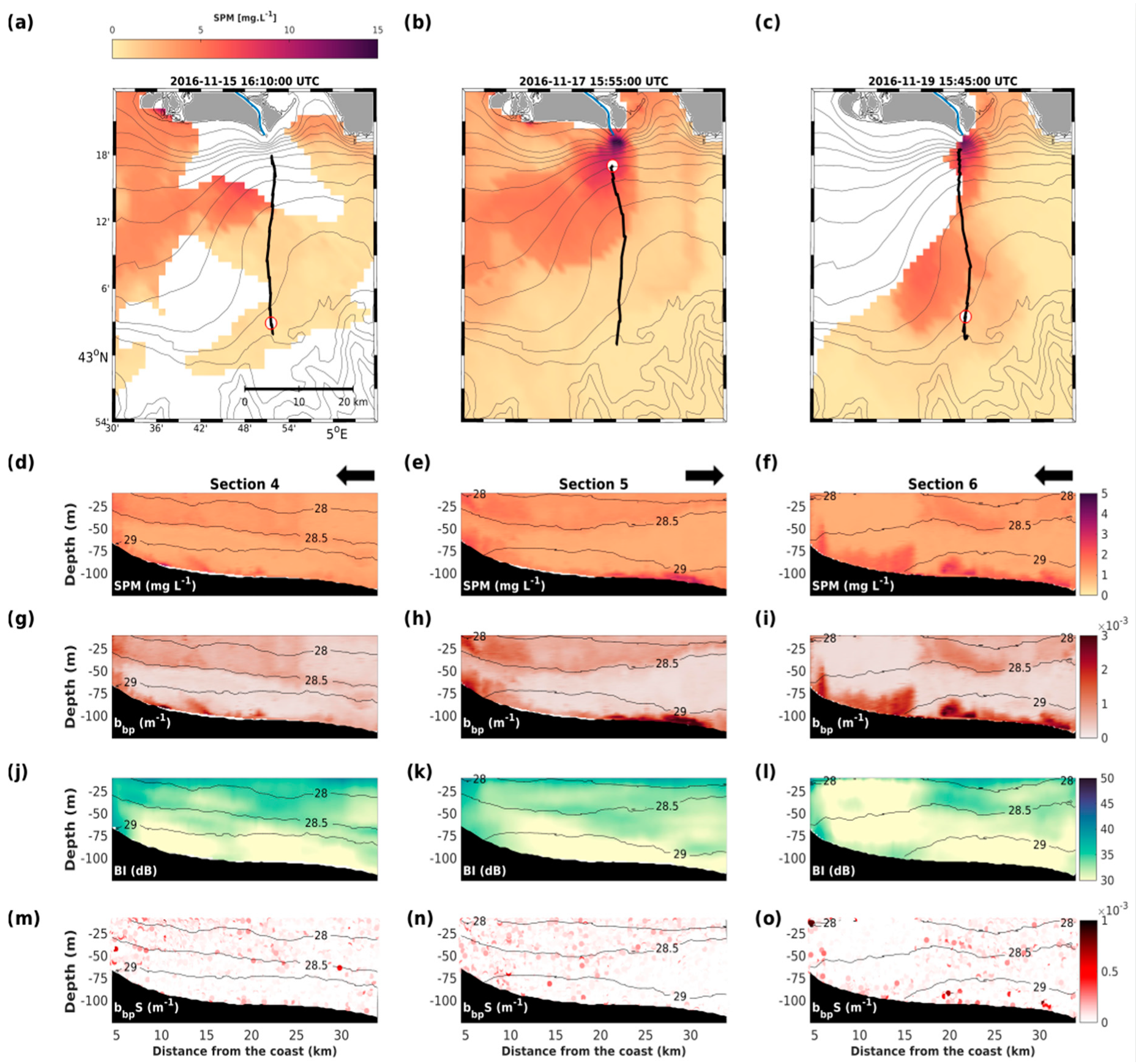


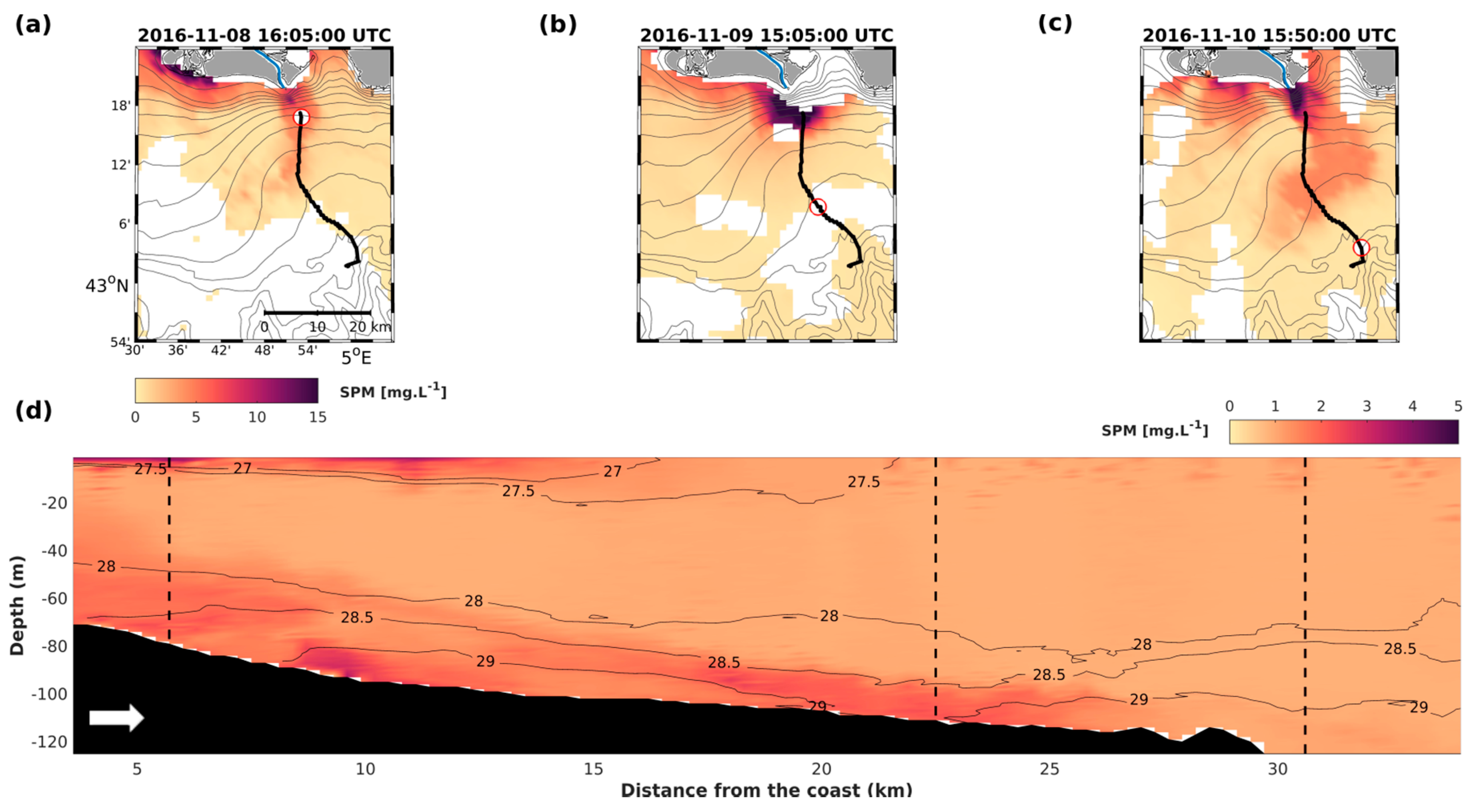
| Observation Time | No. of Data | r2 | |
|---|---|---|---|
| 1 Nov to 12 Nov 2016 | Section 1 | 10,738 | 0.15 |
| Section 2 * | 10,399 | 0.59 | |
| Section 3 | 10,023 | 0.35 | |
| Section 4 | 10,156 | 0.02 | |
| Section 5 | 9752 | 0.68 | |
| Section 6 | 10,256 | 0.72 | |
| Total | 61,324 | 0.69 | |
| 30 Jan to 3 Mar 2017 | Section 1 | 10,343 | 0.84 |
| Section 2 | 10,214 | 0.75 | |
| Section 3 * | 10,661 | 0.61 | |
| Section 4 | 10,307 | 0.68 | |
| Section 5 | 10,615 | 0.74 | |
| Section 6 | 10,221 | 0.79 | |
| Section 7 | 9507 | 0.99 | |
| Section 8 | 10,184 | 0.61 | |
| Section 9 | 10,444 | 0.64 | |
| Section 10 | 10,146 | 0.4 | |
| Section 11 | 10,433 | 0.47 | |
| Total | 113,075 | 0.8 | |
© 2020 by the authors. Licensee MDPI, Basel, Switzerland. This article is an open access article distributed under the terms and conditions of the Creative Commons Attribution (CC BY) license (http://creativecommons.org/licenses/by/4.0/).
Share and Cite
Gentil, M.; Many, G.; Durrieu de Madron, X.; Cauchy, P.; Pairaud, I.; Testor, P.; Verney, R.; Bourrin, F. Glider-Based Active Acoustic Monitoring of Currents and Turbidity in the Coastal Zone. Remote Sens. 2020, 12, 2875. https://doi.org/10.3390/rs12182875
Gentil M, Many G, Durrieu de Madron X, Cauchy P, Pairaud I, Testor P, Verney R, Bourrin F. Glider-Based Active Acoustic Monitoring of Currents and Turbidity in the Coastal Zone. Remote Sensing. 2020; 12(18):2875. https://doi.org/10.3390/rs12182875
Chicago/Turabian StyleGentil, Mathieu, Gaël Many, Xavier Durrieu de Madron, Pierre Cauchy, Ivane Pairaud, Pierre Testor, Romaric Verney, and François Bourrin. 2020. "Glider-Based Active Acoustic Monitoring of Currents and Turbidity in the Coastal Zone" Remote Sensing 12, no. 18: 2875. https://doi.org/10.3390/rs12182875
APA StyleGentil, M., Many, G., Durrieu de Madron, X., Cauchy, P., Pairaud, I., Testor, P., Verney, R., & Bourrin, F. (2020). Glider-Based Active Acoustic Monitoring of Currents and Turbidity in the Coastal Zone. Remote Sensing, 12(18), 2875. https://doi.org/10.3390/rs12182875








